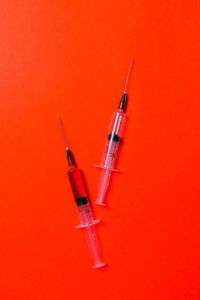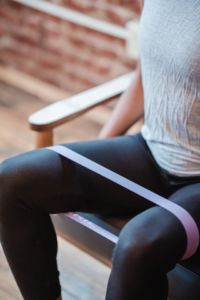
Do you struggle with joint pain caused by osteoarthritis or an injury? Joint pain can make everyday life more difficult. Many arthritis sufferers think that surgery is their only option. The truth is there are safer treatments that relieve pain and slow degeneration. At Vanguard Spine & Sport, we offer innovative treatments, including PRP injections, that can reduce pain and increase functionality for arthritis patients.
Here’s how PRP injections may be integrated into your arthritis treatment plan:

Why PRP Injections?
Osteoarthritis happens when cartilage deteriorates, and the cushioning fluid in the joints thins. Over time the cartilage can wear down completely and leave bones grinding against one another. When the cartilage starts to degrade, the area becomes inflamed. This inflammation is the body’s cry for help, but often the body has trouble answering this call within the joint. If the body doesn’t send enough healing power to the area, then the cartilage will continue to degenerate, and pain and inflammation become chronic. PRP injections answer the body’s call for help and can repair cartilage and prevent further degeneration.
PRP stands for platelet-rich plasma. Plasma is the liquid part of your blood that carries your red and white blood cells throughout your body. Plasma also contains platelets that produce chemicals that signal other cells to begin the healing process when an injury occurs. Your body’s healing process requires good blood flow to work correctly. Often joints, especially knee joints, don’t receive the amount of blood flow they need to heal damage. By injecting the platelet-rich plasma directly into the joint, we can jump-start the natural healing process.
PRP is a very safe procedure because the blood platelets are taken from the patient. Your provider will start by drawing a blood sample. Then they will process the sample in a centrifuge to separate the plasma from the red blood cells. The provider then draws the plasma off and injects it back into the patient at the location of the injury. Sometimes they will use an ultrasound to guide the injection and make sure it gets to the area that needs it most. PRP injections have been proven to be effective for knee and hip pain caused by osteoarthritis.
Because the PRP shot is meant to trigger a natural process, you won’t see overnight results. Over a few weeks, you should notice a gradual improvement as your body heals. Many patients experience continuing improvement for up to six months, and the improvement usually lasts long term. Studies have shown that arthritic knees treated with PRP do not continue degrading at the rate they would have without the shot.
If injections sound uncomfortable, don’t worry, your provider will numb the area first. Most patients need only one or two shots a few weeks apart to begin seeing improvement. You may be able to wait as long as a year before receiving another “booster” shot.
Hyaluronic Acid + PRP Shots
As mentioned above, the second part of osteoarthritis other than cartilage deterioration is the thinning of the cushioning fluid in the joint. This fluid’s technical name is synovial fluid, and your body manufactures it from various compounds. One of the biggest contributors to this fluid is a chemical called hyaluronic acid (HA). This chemical is found throughout your body, mainly in your skin and joints. It attracts water and has a gel-like consistency that keeps skin plump and joints lubricated.
Younger bodies typically produce more HA than older bodies. This is part of the reason why skin tends to lose some of its plumpness as we age. It’s also the reason for an increased risk of joint pain. You can think of the synovial fluid in your joints as being similar to motor oil. When motor oil is new, it has a thick, viscous consistency that helps everything move smoothly. Over time as heat and movement break it down, the motor oil becomes thin and doesn’t lubricate the engine. Synovial fluid also loses its thickness as we age, partially due to decreased hyaluronic acid production.
As with PRP shots, we can help the body by injecting hyaluronic acid where it’s needed. Once it’s within the joint, it begins forming protective barriers around nerves, soothing inflammation and cushioning the joints from shock. It is an effective and safe treatment that can help stop degeneration and reduce pain and stiffness.
In 2018 a double-blind study determined that using both PRP injections and hyaluronic acid injections improved pain and functionality in a group of subjects who were suffering from severe knee pain that impaired their mobility. The study found that patients treated with both types of injections experienced a significant reduction in pain, cartilage degeneration, and bone destruction.
Your Treatment Plan
When you visit our PRP injection providers in Houston, we will create a treatment plan based on the severity of your arthritis and your medical history. We offer several types of injections in addition to PRP and Hyaluronic acid. You may only require one type of injection, or your provider may determine that you’d benefit from a combination. Our chiropractors can also evaluate your spine to determine if spinal degeneration or curvature problems are putting extra wear and tear on your hip and knee joints. Since the body works together as a mechanical system, we believe that addressing the whole body is necessary. Corrective and strengthening exercises and manual adjustments may be a part of your treatment experience. We also offer lifestyle advice and at-home treatment recommendations to help our patients heal faster.
Our goal is to create a doable treatment plan that will result in long-term relief. That being said, we know that arthritis is a chronic issue, and we will also set up maintenance treatments as needed after you have reached your initial treatment goals.
Arthritis doesn’t have to result in reduced mobility and invasive surgeries. Our safe, proven treatments promote real healing and improve both pain and mobility.



